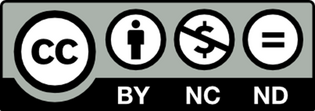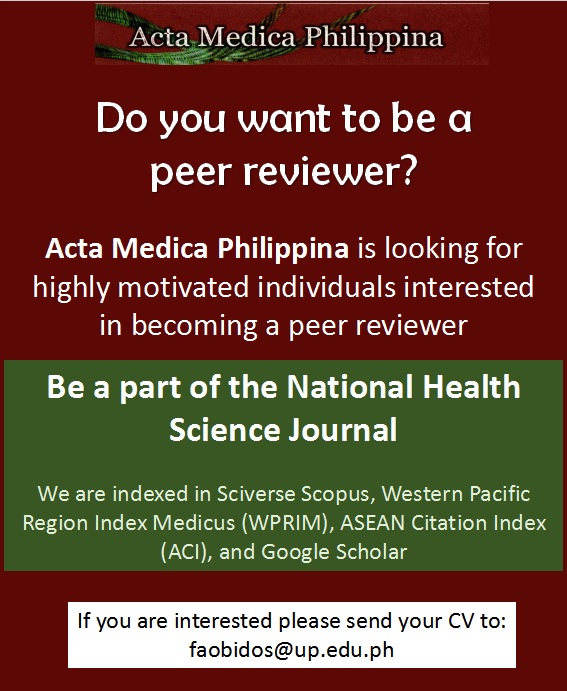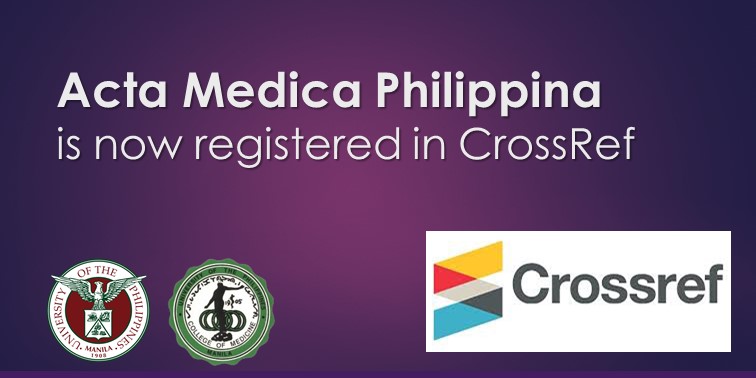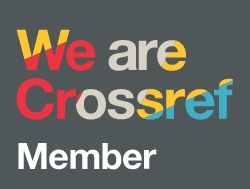Submissions
Author Guidelines
Sections
- Submission Requirements
- Submitting a Manuscript
- Data Validity
- Copyright and Publishing License
- Publication Processing Fees
- Author Guidelines
- Additional Guidelines
Submission Requirements
Acta Medica Philippina accepts original papers, case reports, narrative and systematic reviews, feature articles, and commentaries from any author - provided that certain criteria are met. They should be scientific and/or academic and within the discipline of human health sciences.
Manuscripts are received with the understanding that they are not under simultaneous consideration by another publisher. Copyright of articles published in Acta Medica Philippina is assigned by the publisher to the authors. Submitting an article for publication in the Journal signifies consent by all authors.
Both parties should also comply with the stated license. These manuscripts are submitted on the condition that they can be subject to editorial modifications to bring them in conformity with the scientific and integrity standards of the journal as well as its standard layout.
Although the Journal undertakes due diligence in verifying the information included in each manuscript, statements or views expressed in the articles are not the responsibilities of the Editors and/or Publisher. The authors maintain equally this responsibility. All authors are required to sign documents signifying agreement with this responsibility.
Submitting a Manuscript
Authors need to register on the Journal website to submit a manuscript. The Journal uses the Open Journal System (OJS) platform. Users must create a profile providing User and Password details. These need to be provided by the user each time they want to use the portal to track their submissions and/or communicate with editorial staff. All communications related to submitted manuscripts should be coursed through the portal. Each manuscript submitted will be provided with a unique reference/tracking number. Users are updated through the email that they have provided. Links are provided in the emails to allow opening of the particular submission but authors would still need to login in with their details to respond to the queries and/or updates.
Details about submissions, including their status in the publication workflow, comments from peer reviewers, submission of revisions, and other communications are visible through the portal. Authors may use this to review previous communications about a particular manuscript. Different manuscripts, even if submitted by the same author(s) will be located in different manuscript threads through the portal.
Inquiries and other clarifications related to the manuscript submission are entertained only through the Journal portal. Users must log in to access the details of their submission.
Contact details of Editorial staff are provided in the website. However, all communications related to a submission should be coursed through the OJS portal in order to capture all aspects of discussions related to the submission.
Data Validity
By default, a five (5) year interval between the date of the last data and the date of initial submission of the manuscript for possible publication is imposed. For example, data involving January 2022 to December 2024 will mean the date of the last data is December 2024. In order to comply with this requirement, the manuscript should be submitted by December 2029. The date does not refer to the completion of data gathering, data analyses, and/or manuscript writing. This is to ensure that the data provided remains relevant in an evolving human health landscape.
Exemptions may be considered if authors can explain why the data remains valid despite being more than 5 years old.
Copyright and Publishing License
- Copyright is owned by the Authors listed in the manuscript.
- Sponsors and funding agencies who require that copyright and license is assigned to them will mandate the authors to inform the journal through a written request. This is the sole responsibility of the authors. The journal will not be involved in this activity.
- Articles are published under a Creative Commons Attribution-NonCommercial-NoDerivatives License (https://creativecommons.org/licenses/by-nc-nd/4.0/).
- Further details of this license can be viewed here (https://creativecommons.org/share-your-work/cclicenses/?form=MG0AV3
- This license allows sharing (copy, distribute, and display in any format) non-commercially as long as it is attributed.
- This license prevents others to remix, crop, translate, annotate, adapt, and/or build upon the work even if properly attributed.
- Commercial use are subject to other provisions
- Commercial use needs the permission of both the Journal and all relevant copyright owners. See below
- A fee is charged by the journal for such commercial use. This is currently set at PhP 30,000.00 for each article or its equivalent in foreign currency for each commercial activity.
Commercial Use
The Journal defines commercial use as any activity where the published article is used for profit-making purposes or in a way that benefits a business financially. This can include, but not confined, to the following:
Selling or redistributing the article for a fee.
- Using the content in paid training programs or corporate research reports.
- Incorporating figures, tables, or text into commercial products, such as pharmaceutical or commercial treatment claims, textbooks, or software.
- Reproducing the article in marketing materials or advertisements.
- Charging for access to the article through a subscription or paywall.
Fair use, which allows limited reproduction for purposes like criticism, commentary, teaching, or research, is allowed.
UP Manila, as the publisher, also reserves the right to impose any applicable Intellectual Property Rights provisions as defined by the UP System and/or the national government.
Relevant provisions of the Intellectual Property Code of the Philippines (RA No. 8293) are deemed applicable as well.

https://creativecommons.org/licenses/by-nc-nd/4.0/
Publication Processing Fees
The Journal charges processing fees to evaluate manuscript submissions from outside the Philippines. No evaluation for compliance with Journal requirements and progress of the submission will take place until complete payment is received by the Journal. Manuscripts considered inappropriate at the outset for publication by the Journal do not need to pay the processing fee.
Payment of fees do not guarantee publication.
All submissions need to comply with the requirements of the Journal as part of the quality assurance and due diligence needed to ensure transparency, integrity, and ethical conduct of scientific publications. These include the documentary requirements and undergoing peer review. Regardless of payment, manuscripts will also need to satisfy editorial decisions.
Submissions from Outside the Philippines
Material/s originating from outside of the Philippines are covered in this requirement. These include studies done and/or involving patients coming from outside of the Philippines. This applies as well to manuscripts that include some authors connected with Philippine institutions.
- For individual manuscripts, a fee of USD 250.00 needs to be paid before any evaluation can be made.Bank transfer details will be provided upon request. Author(s) will still need to comply with submission requirements as detailed.
- For several manuscripts that are intended to be published together in a single issue, (Institutional Issues), host institutions will need to pay USD 5,000.00. A minimum of 11 and a maximum of 15 manuscripts is recommended for these issues. Bank details will be provided upon request.
Submissions from the Philippines
Individual submissions from authors connected with Philippine public or private learning institutions currently do not need to pay the processing fee.
Individual submissions from authors connected with commercial institutions (e.g., pharmaceutical and/or marketing companies) will need to pay PhP 30,000.00. The commercial use of any published article is covered under the Section on License.
Institutional Issues (a compilation of 11-15 articles in a single issue) will require payment of a processing fee. This is set at PhP 250,000.00. Bank details will be provided upon request. No processing of manuscripts included in such institutional issues will be done prior to full payment of the processing fees.
Any study that has received institutional assistance for publication (e.g., from a sponsoring agency) will need to pay a processing fee that is at least 50% of the publication assistance received; subject to the provisions of the sponsoring agency. All submissions require an attestation of whether publication assistance was received. The Journal can provide an Acknowledgement or Official Receipt in the name of the sponsoring agency for such fees.
Author Guidelines
The editorial policies of Acta Medica Philippina follow the recommendations of the International Committee on Medical Journal Editors (ICMJE) and the ethical guidelines of the Committee on Publication Ethics (COPE).
http://www.icmje.org/recommendations/browse/manuscript-preparation/preparing-for-submission.html
https://publicationethics.org/
Author Disclosure of Interest
Authors are required to disclose any interest, relationship/s, or potential conflicts of interest upon submission of their manuscript.
Each of the authors must accomplish and submit the ICMJE Disclosure of Interest (Updated July 30, 2025):
Author Signature Form
The submission must include the accomplished Author Signature Form that you may download from this link:
https://docs.google.com/document/d/1eX5izscLiHCOJgtkTgNg3G3qFtdeHxF7/edit?usp=sharing&ouid=118348432341627575380&rtpof=true&sd=true
Corresponding Author Form
The submission must include the accomplished Corresponding Author Form that you may download from this link:
Attestation Form
The submission must include the accomplished Attestation Form that you may download from this link:
https://drive.google.com/file/d/18iyFaTg9AgnezkSMsT54FfiyW4_Jszbq/view?usp=share_link
Plagiarism
Plagiarism is defined by the Journal as the presentation of a piece of work that has been copied in whole or in part from the work of another individual or group of individuals (for example, someone else’s work, partly or in entirety, published or unpublished books, periodicals, internet sites, etc.) without proper documentation and/or acknowledgement.
Even if articles and/or work are cited, but substantial portions are incorporated, and/or very little original information is provided, it can still be considered as plagiarism. Infrequent and occasional self-citation may be allowed if found appropriate (e.g., for previously published study procedures and/or data).
The Journal uses software and editorial scrutiny to detect possible plagiarism.
Author(s) may be given the opportunity to make revisions and/or respond to clarification regarding instances of possible plagiarism.
Preprints
The Journal accepts manuscripts that have been uploaded to any preprint server. A link to the uploaded manuscript must be provided.
Ethics Review Approval
For Original Articles and Case Reports, authors are required to submit a soft copy of the Ethics Review Approval of their research or a document that their study is exempt from review by the IRB. For manuscripts reporting data from studies involving animals, authors are required to submit a scanned copy of the approval from the Institutional Animal Care and Use Committee or its equivalent.
Informed Consent
The author must state in their submitted manuscript that subjects had read, signed, and possess a copy of their Informed Consent Form (ICF). The ICF must have a statement that says that the subject understood that research results can be used for publication, but that all personal identification will remain confidential.
All interventional studies (clinical trials) require a statement that individual patient ICFs have been obtained.
Copies of individual ICFs are not required for submission.
In the case of non-interventional studies and case reports, a general consent form to use patient data as obtained by the institution upon patient admission is acceptable for this purpose. A statement that such consent has received institutional legal approval however needs to be included.
Preparation of Manuscript
- The manuscript should be in Microsoft Word® or a similar format.
- The document should be accessible by anyone without any passwords.
- It should not contain any unnecessary format that affects future layout according to the Journal’s style (e.g., EndNotes).
- The text should be in a single column, single-spaced; in 12-point Arial font. It employs italics, rather than underlining (except with URL addresses). All illustrations, figures, and tables are placed within the text at the appropriate points, rather than at the end. Appendices and other attachments or supplements are placed at the end after the References.
- Tables are numbered chronologically using Roman numerals as they are mentioned in the manuscript
- Figures and Images are numbered chronologically using Arabic numerals as they are mentioned in the manuscript.
- Images that can identify a patient should be anonymized. This includes pictures of faces, identifying tattoos (unless required in the report), and diagnostic images such as radiologic plates, hospital numbers, etc.
- References are formatted according to the AMA (Vancouver) referencing style. These are numbered chronologically according to the order they are cited in the manuscript text. The number should appear as superscripts at the end of the statements where they are used, after the period. Multiple citations should be placed at the end of the sentences that used them after the period. References that are utilized more than once should use the same number as when first cited. (See Author Guidelines)
- The corresponding author must fill in all the required fields in the metadata of ALL contributors (complete name with middle initial, email address, country, complete affiliation - department and institution, no acronym). Submissions that fail to comply with the above requirements may be subject to delay in processing.
- The journal reserves the right to decline a submission that has remained inactive for more than 60 days.
- The author(s) can re-submit all requirements if they would like to pursue the submission.
EQUATOR Network Reporting Guidelines
To help in reporting their findings and writing the study for publication, depending on the study type, authors are strongly encouraged to use the EQUATOR (Enhancing the QUAlity and Transparency of Research) Network Guidelines study reporting guidelines.
These guidelines are available at: http://equator-network.org
An algorithm provided by the EQUATOR Network can help authors determine which reporting guideline should be used for their manuscript.
https://www.equator-network.org/toolkits/selecting-the-appropriate-reporting-guideline/
- CONSORT (2010) Checklist for Reporting Clinical Trials
- CARE (2013) Checklist for Reporting Case Reports
- COREQ (2007) Checklist for Reporting Qualitative Research
- PRISMA (2009) Checklist for Reporting Systematic Reviews and Meta-Analyses
- STROBE (2007) Checklist for Reporting Observational Studies
- STARD (2015) Checklist for Reporting Diagnostic Accuracy Studies
- CHEERS (2013) Checklist for Reporting Economic Evaluation of Health Interventions
- SQUIRE (2015) Checklist for Quality Improvement Reporting in Healthcare
- ARRIVE (2013) Guidelines for Reporting Animal Research
Copies of these checklists can be found here:
https://drive.google.com/drive/folders/1lmJWeDVyvc2sxDKXwBdV1tgD95bW6OAu?usp=sharing
Acta Medica Philippina shares these checklists with peer reviewers for their possible use in reviewing the manuscripts (See Peer Review policies and procedures)
Additional guidelines are provided below for specific parts of the manuscript:
Abstract
For original articles, the abstract should have a structured format consisting of the Introduction, Methods, Results and Discussion, and Conclusion (IMRAD format). Case Reports can provide a Case Summary instead (see below). Authors are strongly advised to limit their An Abstract should not exceed 500 words. Any unduly long Abstract can result in a manuscript being returned to the authors for revision.
For Case Reports, a Case Summary is provided which includes a Background, Case Presentation, and Conclusion. The Case Summary should not exceed 500 words.
Keywords
At least three (3) keywords using terms from the Medical Subject Headings (MeSH) list of Index Medicus should be listed after the abstract for cross-indexing of the article.
https://www.nlm.nih.gov/mesh/meshhome.html
Text
- The text should be organized consecutively as follows: Introduction, Materials and Methods, Results, Discussion, and Conclusion.
- All references, tables, figures, illustrations, appendices, or any other attachments should be cited or mentioned in the text in chronological order. References, Tables, Figures or Illustrations, and Appendices and Attachments that are not mentioned in the text shall be removed and will not be included in the published article.
- All abbreviations should be spelled out when used for the first time in the text, followed by the abbreviations enclosed in parentheses (e.g., University of the Philippines (UP)).
- All measurements should be in System International (SI) units. Alternative measurements, such as those in the English or Imperial system can be placed in parentheses.
- Acknowledgments to individuals/groups of persons or institution/s can be included at the end of the text just before the references. Grants and subsidies from government or private institutions can also be acknowledged as Funding support or Study Grants.
References
- References in the text should be identified by Arabic Numerals in superscript on the same line as the preceding sentence.
- References should be typed single-spaced and numbered consecutively in the order they are mentioned in the text.
- References (numbers) should be cited at the end of the sentence where they are included after the period.
- References that are not clearly cited in the manuscript will be removed. If needed, the manuscript will be returned to revise the chronology of the references.
- Manuscripts that do not conform to this referencing format shall be returned for revision
- The style approved by Acta Medica Philippina conforms to that recommended by the ICMJE and should follow the format of the examples shown below:
Journal Article
Qirjazi E, Kaunda J, Andersen T, Peterson J, Iwaasa K, MacRae J, et al. SARS-CoV-2 shedding in dialysis patients with COVID-19. Kidney Int Rep. 2021 Nov;6(11):2897-99. doi: 10.1016/j.ekir.2021. 08.016. PMID: 34466759. PMCID: PMC8393503
Electronic Material
Centers for Disease Control and Prevention, Falls among older adults: summary of research findings [Internet]. 2005 [cited 2006 Jan]. Available from:
https://www.cdc.gov/ncipc/pubres/toolkit/SummaryOfFalls.htm.
Preprint Article
Bloss CS, Wineinger NE, Peters M, et al. A prospective randomized trial examining health care utilization in individuals using multiple smartphone-enabled biosensors. Preprint. Posted online October 28, 2015. bioRxiv 029983. doi:10.1101/029983
Book
Dumitru D, Amato AA, Zwarts MJ. Nerve conduction studies. In: Dumitru D, Amato AA, Zwarts MJ, eds. Electrodiagnostic medicine, 2nd ed. Philadelphia: Hanley and Belfus, Inc; 2002. pp. 159–217.
For more reference style and format, follow the standards in the ICMJE Recommendations found in this link.
Tables
- Cite all tables consecutively in the text and number them accordingly. The content of tables should include a table number (in Roman numerals) and a title above the table. Explanatory notes and legends as well as definitions of abbreviations used are listed after the table.
- Each table must be self-explanatory being a supplement rather than a duplicate of the information in the text. Authors should refrain from just repeating in the text what would normally be completely included in the tables. The use of too many tables is discouraged.
Figures and Other Images
- The definition of Figures includes pictures, images, graphs, and illustrations. These should be identified by Arabic Numeral/s numbered sequentially according to the order they are first mentioned in the text. Each should have appropriate titles, descriptions, and other explanations which should be placed under the figures.
- The numbers should correspond to the order in which the figures/graphs occur in the text. It is recommended that figures/graphs are also submitted as high-resolution image files (preferably as .jpeg or .tiff files).
- All personally identifying data of the subject/s or patient/s under study such as names, case or hospital numbers, etc., should be removed.
Illustrations and Photographs
- Digital photographs should be at least 800 x 600 pixels.
- For photomicrographs, the stain used (e.g., H & E) and magnification scale (e.g., 500x magnification) should be included in the description.
- Identifying arrows or other means to point to a specific area included in the illustrations and photographs should be part of the picture and not a separate object.
Once submission requirements are completed, manuscripts are sent for peer review (see Peer Review)
In addition to the above, authors may also use the ICMJE recommendations for Preparing a Manuscript for Submission to a Medical Journal. However, the provisions above should take precedence.
https://www.icmje.org/recommendations/browse/manuscript-preparation/preparing-for-submission.html
Thesis reports are not acceptable as submissions. Authors should revise these to comply with ICMJE recommendations. Table of Contents, List of Figures and Tables, Review of Literature, etc. are not to be included in a manuscript intended for publication in the journal.
The journal recommends an absolute maximum length of 10,000 words, excluding references, for any single manuscript submitted for consideration. The journal reserves the right to return or decline a manuscript that is longer than this.
Submission Preparation Checklist
All submissions must meet the following requirements. Failure to include any of these documents can cause delay in the evaluation of the submission.
- The submission has not been previously published, nor is it before another journal for consideration (or an explanation has been provided in Comments to the Editor).
- The corresponding author must fill-in all the required fields in the metadata of ALL contributors (complete name with middle initial, email address, country, complete affiliation - department and institution, no acronym). Submissions that fail to comply with the above requirements will be declined. The author will have to submit again.
- All the listed authors have been sufficiently involved in this submission to take public responsibility for its validity and final presentation as an original publication.
- All authors understand that the Corresponding Author is responsible for communicating with the other authors about the status of their submitted manuscripts, results of peer reviews and/or comments, submission of revisions as appropriate, and final approval of galley proofs.
- The manuscript upon submission should not contain any identifying information (authors’ names, affiliations, contact details, etc.). These details should be provided in the Author Signature Form.
- The sequence of author(s)’ names should be specified beforehand. This is stated in the Author Signature Form. In case of change in this sequence or addition/removal of the author(s), all the other authors in addition to the Corresponding Author need to sign off on the request for change of authorship.
- By default, only two (2) authors are allowed to be designated as first or lead authors. These would normally be the first 2 as written in the published article. More than that will require a strong justification to be signed by all the authors of the manuscript.
- The submission must include the accomplished ICMJE Disclosure of Interest (Updated February 2021) for each author. Download the Form here: https://docs.google.com/document/d/1NJVxMgeJilJSJFJBKI6ygQFt0bJihO8K/edit?usp=sharing&ouid=118348432341627575380&rtpof=true&sd=true
- The submission must include the accomplished Author Signature Form that you may download from this link https://docs.google.com/document/d/1eX5izscLiHCOJgtkTgNg3G3qFtdeHxF7/edit?usp=sharing&ouid=118348432341627575380&rtpof=true&sd=true While the Corresponding Author Form can be downloaded from this link: https://docs.google.com/document/d/1D3G7kEL-me3Oa2vEARckzECYhBvl8DxW/edit?usp=sharing&ouid=118348432341627575380&rtpof=true&sd=true
Copyright Notice
Copyright is assigned by the Publisher to the Authors listed in the article.
Privacy Statement
The names and contact details provided to the journal submission portal will be used exclusively for getting in touch with the Corresponding Author concerning the submission. In line with the journal peer review policy, authors may be invited to participate in peer review of future submitted manuscripts. Acceptance of manuscripts will not be affected by acceptance to do peer review.
All contact details are not made available to external parties. The contact details of the Corresponding Author in the publication are included to allow readers to get in touch with the authors for clarifications and other purposes which may be related to the article.




.jpg)



